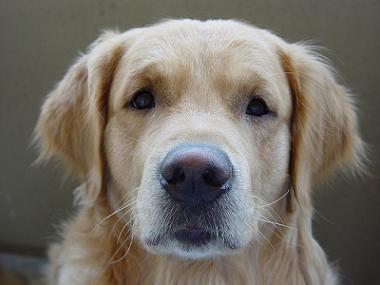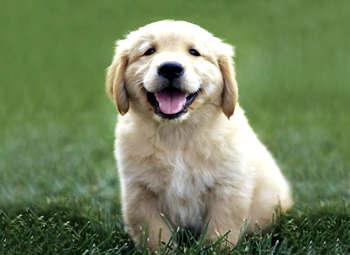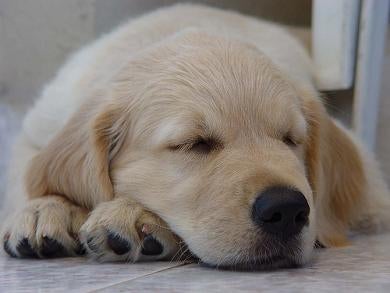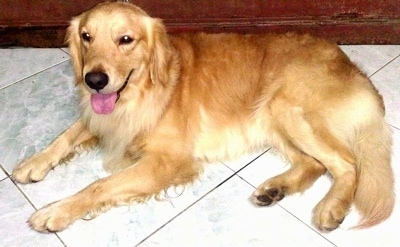Golden Retrievers are an outstanding human companion dog - they display a long list of traits which us dog lovers admire and value.
The Golden Retriever is much loved all around the world for their gentle affectionate nature, high intelligence, absolute loyalty and attractive good looks. They are one of the few dog breeds who truly build a strong and lasting bond with their human family.
Golden Retriever puppy training is an essential, fun and rewarding experience for you and your dog. You'll find that your Golden Retriever puppy may be a bit unruly and excitable early on but with some puppy socialization and training will develop into a wonderful trustworthy companion.
Golden Retriever Breed Information
The Golden Retriever is a relatively modern sporting dog breed. Fortunately for us dog lovers the Golden Retriever was developed in Scotland in the late 1800's by Dudley Majoribanks. They were initially bred to be superior hunters - to this day they still love to retrieve.
Since then the Golden Retriever has been known as a Golden, Yellow Retriever or simply as a Goldie.
The Golden Retriever has a lovely warm gentle expression, is athletic, muscular and has a smooth fluid gait. They love to greet you with their head held high and tail wagging furiously.
One of the most distinctive features of the Goldie is their beautiful rich golden coat. It is a thick double coat which is weatherproof - they do shed!
Goldies are a powerful well proportioned dog, males grow to 56-61cm tall at the withers and weigh in at between 29-34kg. Females are a centimeter or two shorter and a couple of kilos lighter.
The easy to handle and very trainable nature of the Golden Retriever has seen them utilized in many "canine jobs". Their love of human company and patience has made them ideally suited as guide dogs for the blind, service dogs and also as narcotic detection dogs.
Golden Retriever Temperament
Anyone who has had the pleasure of living with a properly socialized and trained Goldie will agree that their temperament is what makes them so special.
Golden Retrievers absolutely crave and thrive on human attention. They are happiest when involved in all family activities - they are not an outside dog. Therefore if you are away from home for long periods a Golden Retriever puppy is probably not the right option for you. Separation Anxiety can be a problem with Goldies that are left alone and bored for hours on end.
Golden Retriever puppies grow to be confident, friendly to all people and animals, well mannered, patient, inquisitive, adaptable and stable. Basically they are a great asset to any responsible dog loving household.
Goldies love to swim, retrieve a ball and enjoy all types of dog sports and training. They appreciate the physical and mental stimulation which activities like agility, flyball, tracking and obedience training provides.
Golden Retriever Health Problems
Golden Retriever breeders play a crucial role in the future of the breed. A concientious and reputable Golden Retriever breeder will do all they can to protect the health of the breed going forward. All of their breeding stock will be screened accordingly and all litters will be carefully planned.
It's an unfortunate fact that there are many unscrupulous and opportunistic Golden Retriever breeders out there cashing in on the vast popularity and money making potential of the breed. They have little or no regard for the mental and physical wellbeing of the Golden Retriever puppies they produce. This has led to a disturbing increase in Golden Retriever puppies with unstable temperaments.
Golden Retrievers are still a pretty sturdy and healthy breed but there are a few problems to look out for:
- Hip Dysplasia is a common problem in Golden Retrievers - as it is with many of the larger dog breeds. It's an inherited defect which means that the hip joint is unsound. Your Golden Retriever breeder should be able to show you hip clearance x-rays of all of their breeding stock.
- Elbow Dysplasia is also prevalent in Goldies - similar to Hip Dysplasia.
- Eye Disease can be a problem in your Goldie. Hereditary cataracts are fairly common and Central Progressive Retinal Atrophy (CPRA) is also common. Once again checking the parents and grand parents of your puppy is your best guide.
- Hereditary Heart Disease and epilepsy are other health problems that Goldies can be susceptible to.
So if you want a healthy, well socialized Golden Retriever puppy the best place to start is by locating a good Golden Retriever breeder - they are your valuable ally.
Golden Retriever Puppy Training Is Tiring Stuff!Golden Retriever puppies require proper socialization and at least basic obedience training in order to reach their full potential. The good news is that Goldies are willing and very capable students who are very trainable.
Golden Retriever puppy training is most effective when using positive, reward based dog training methods with plenty of encouragement and praise. You'll find that your Goldie is eager to please when training and won't benefit from any harsh punishment or force.
From puppy house training (potty training), crate training right through to all the basic obedience commands (sit, down, stay, heel, come etc.) your Goldie will catch on quickly. All they require from you is some clear guidance, consistency and repetition.
 a mug that is ferocious, sour and comical all wrapped up in the same package, the bulldog will adore you while still at times tend to follow his own lead rather than yours.
a mug that is ferocious, sour and comical all wrapped up in the same package, the bulldog will adore you while still at times tend to follow his own lead rather than yours. With love and the proper training the English Bulldog Puppy will grow up to a calm adult dog. Bulldogs enjoy leisurely walks through the neighborhood meeting everyone. English Bulldogs will cheerfully adopt anyone and everyone.
With love and the proper training the English Bulldog Puppy will grow up to a calm adult dog. Bulldogs enjoy leisurely walks through the neighborhood meeting everyone. English Bulldogs will cheerfully adopt anyone and everyone.  The English Bulldog meets no stranger. Your Bully is your best companion. Being a friend may be the most important job your English Bulldog has. When you stop and think about the Bully's role, that's not such a bad job description. The English Bulldogs are very content to be your low-maintenance buddy. He will never be a great guard dog because the Bulldog prefers a snooze on the couch. Bullodgs are predisposed for lounging around. After a long day at work, rest assured that your Bully pal will be waiting for you to snuggle alongside. So if you want a companion to hang out with after a hard day's work, then the English Bulldog may just be the type of pet you are looking for.
The English Bulldog meets no stranger. Your Bully is your best companion. Being a friend may be the most important job your English Bulldog has. When you stop and think about the Bully's role, that's not such a bad job description. The English Bulldogs are very content to be your low-maintenance buddy. He will never be a great guard dog because the Bulldog prefers a snooze on the couch. Bullodgs are predisposed for lounging around. After a long day at work, rest assured that your Bully pal will be waiting for you to snuggle alongside. So if you want a companion to hang out with after a hard day's work, then the English Bulldog may just be the type of pet you are looking for. 








